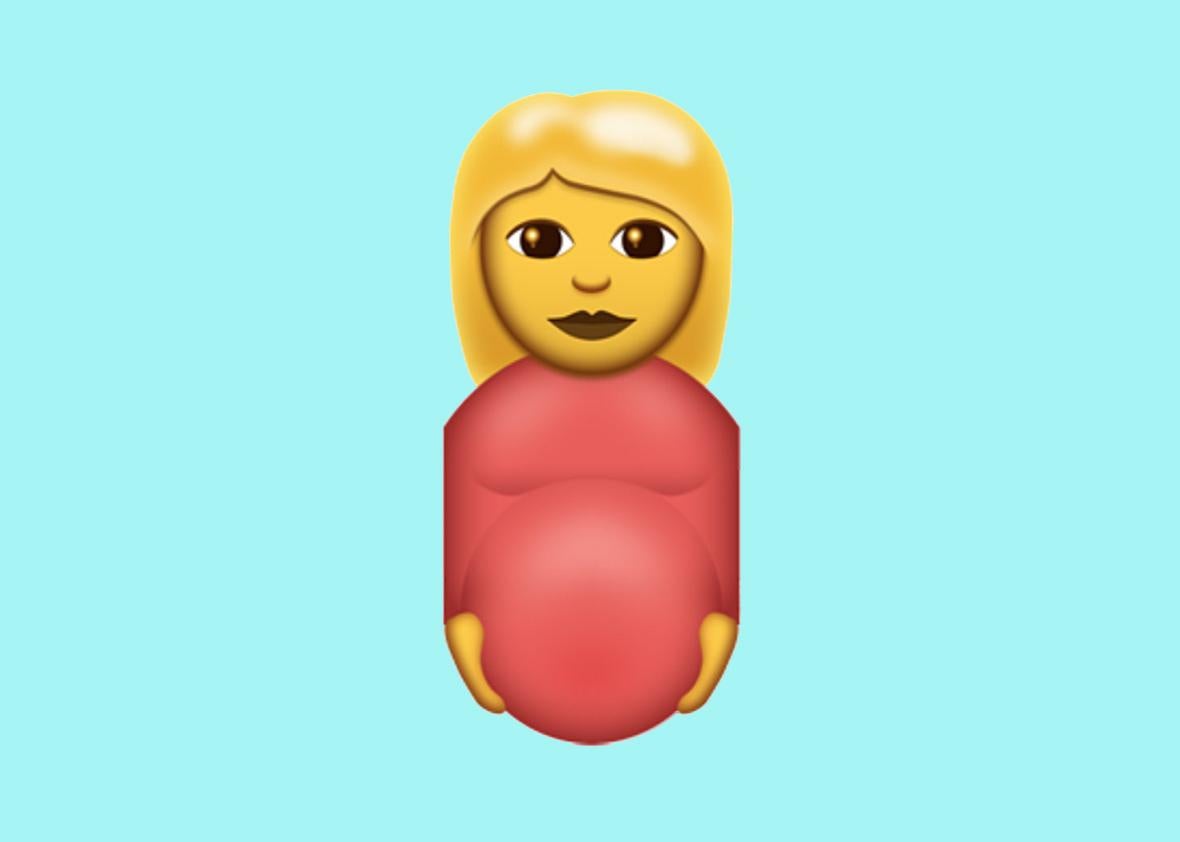This week the Unicode Consortium, a nonprofit organization responsible for coordinating and standardizing code across the computing industry, released 72 new emojis. They include men wrestling, a man playing water polo, a man playing handball, and a man juggling. Absent are women playing sports or working jobs or doing much of anything at all, unless you count the ones shrugging or face-palming—or Mrs. Claus, whose exact responsibilities I’ve never understood. The only other new woman-specific emoji is a pregnant woman.
That a pregnant woman is the singular attempt to diversify the life of emoji women isn’t surprising. We’re living in an era of unprecedented fascination with the baby bump. Tabloids meticulously monitor the midsections of celebrities, including those who have announced their pregnancy and those who haven’t and show little interest in becoming so. Unfortunately for the rest of us, unfamous bumps receive outsize attention these days, too. There’s a new app called BellyBump designed—by two actors and a musician—to create time-lapse videos of growing bumps. The large numbers of women who catalog the rise and fall of their midsections during and after pregnancy on Instagram suggests there is a real market for this.
I’m not immune to the excitement occasioned by pregnancy. But I am also not immune to the prodigious scrutiny placed on women’s bodies, nor to the fact that our love of mothers with children in utero doesn’t necessarily translate to a love of mothers after their babies are born. Bumps are sweet, but less attention paid to women’s bodies and more attention paid to affordable childbirth and paid parental leave would be sweeter.
There are other gestures towards inclusivity among the new emojis. In addition to Mrs. Claus, there’s a prince (suggested companion for the princess), man in tuxedo (suggested companion to the bride with veil), and a male dancer (suggested companion to the female dancer.) It’s an improvement tempered by the fact that these emojis read more as part players in a familiar, gendered narrative than a tech-world-worthy disruption of the gendered status quo.
But more female emojis may not be far off. Over the past year there has been a push towards more diverse representation of women, including Amy Butcher’s op-ed in the New York Times arguing for “Emoji Feminism” and Google’s recent proposal of 13 new female emojis, including a scientist, a healthcare worker, and an engineer. A 2015 report on emoji use found that 92 percent of people on the internet use emojis, with women taking the lead over men. (Specifically, 78 percent of women report using emojis frequently, compared to 60 percent of men.) The appeal of incorporating these Simpsons-hued symbols into our digital exchanges lies largely in their ability to imbue our written messages with tone. A cartoon expression or addition of a pile of pancakes can render our words playful, compassionate, or ironic—an adjustment otherwise achieved by adjusting the timber of our voices. Emojis are quickly becoming an important part of how we communicate, which makes the fight for inclusivity more important than a cause célèbre among the politically correct; it’s an attempt to make an increasingly relied upon language reflect the world it is being used to describe.
The fact that Unicode neglected to raise the number of women doing things this time around has less to do with indifference, and more to do with the slow process of making things happen at an international consortium. (Also, there have reports that some members of Unicode would prefer to spend less time on emojis and more time on their original mission of translating alphabets, new and old, into code that can be read by all computers.) Jeremy Burge, the founder of Emojipedia.org and a member of Unicode’s Consortium’s Emoji Subcommittee, told the Guardian that Google’s proposal was convincing and “pragmatic from an encoding point of view” and suspects it could be implemented sometime this year. “It’s pretty clear that female-oriented professions are under-represented in emoji, and this approach is a clever way to address the issue now, rather than pushing it down the line,” he told the paper, adding that the issue will be discussed at a Unicode meeting in August. Hopefully this means that emoji construction workers, police officers, and sleuths will start getting female coworkers soon.
